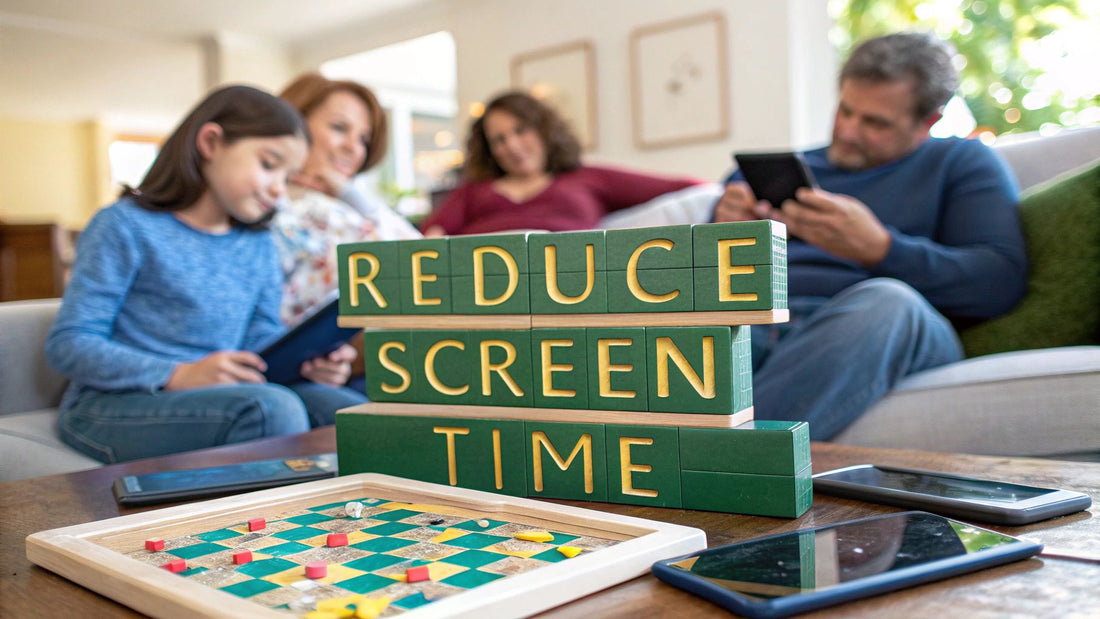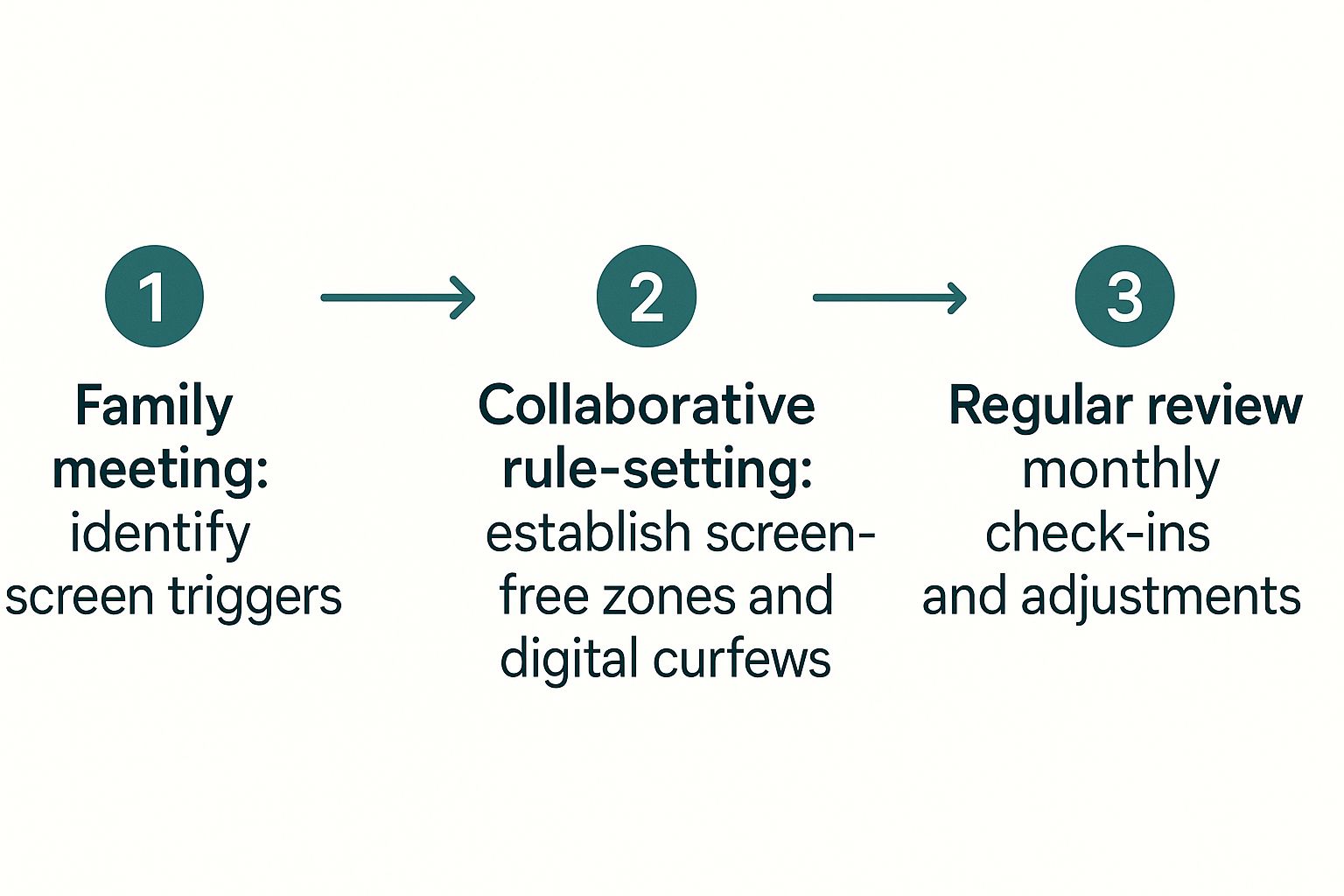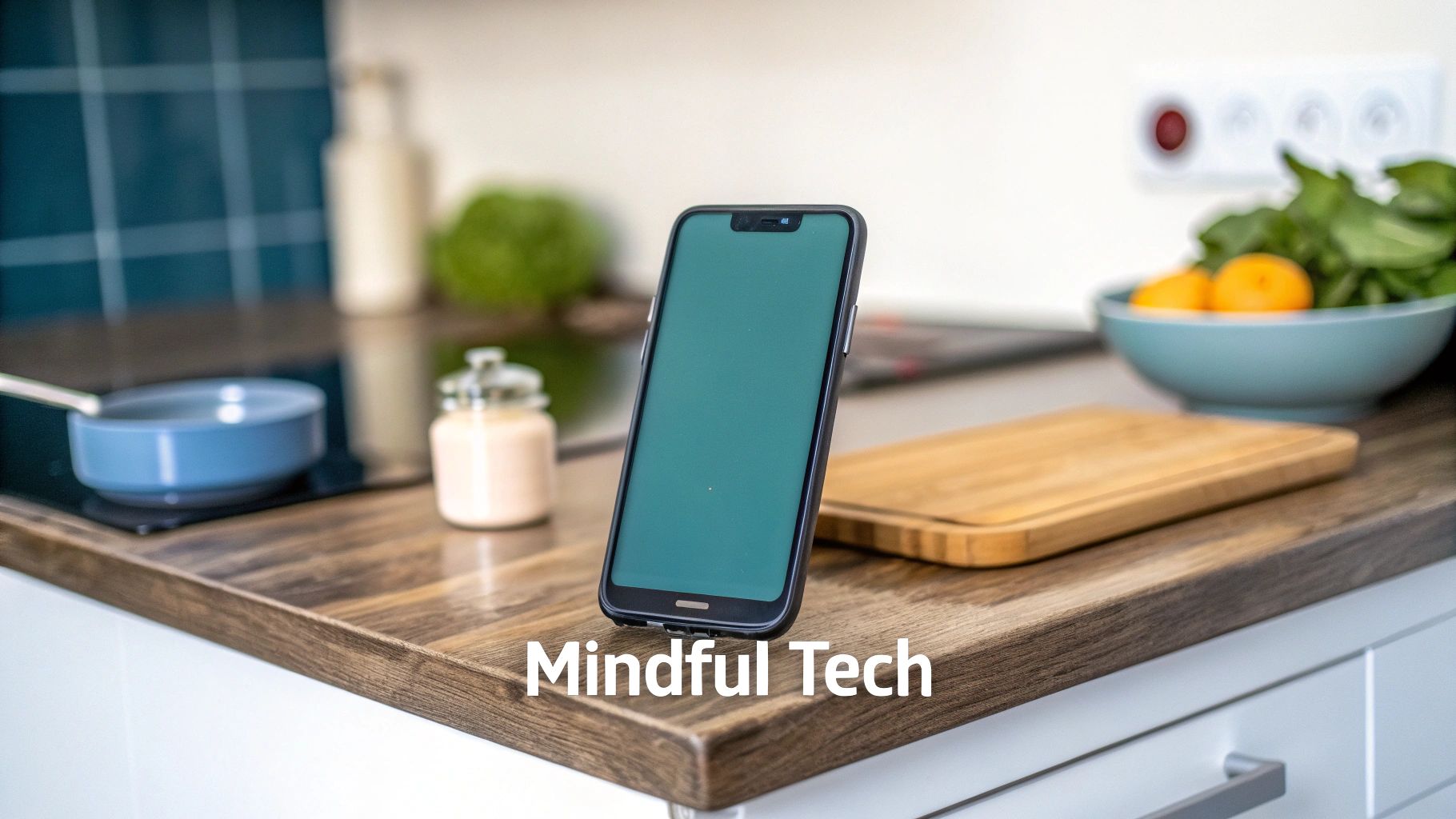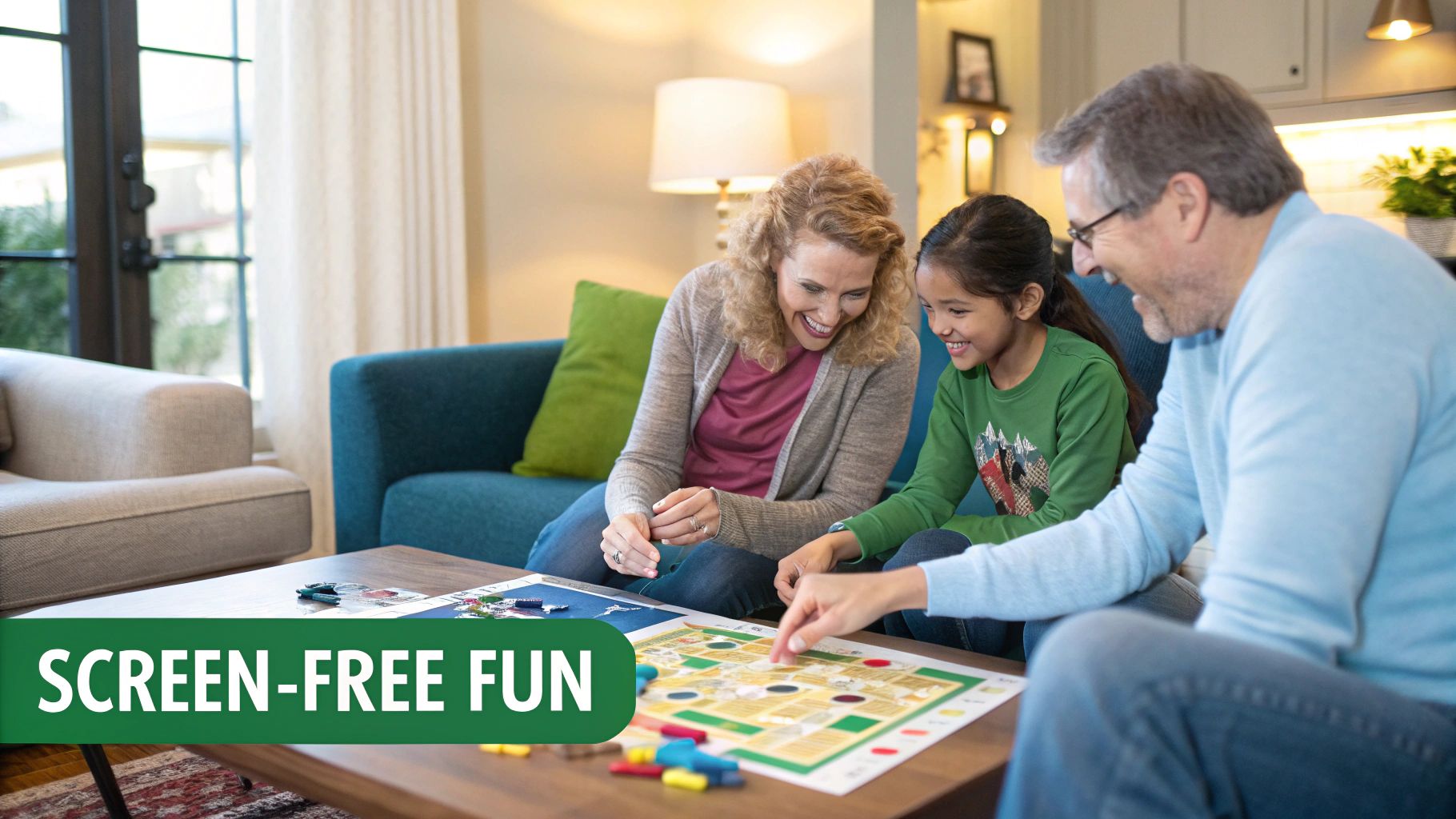
How to Reduce Screen Time A UK Family Guide
Share
Before you can start cutting down on screen time, you need to get a really clear, honest picture of where your family is right now. It’s not just about counting the hours spent on devices; it’s about understanding why everyone is plugged in and what they’re doing. This gives you a starting point, a baseline, so you can set goals that are actually achievable for everyone.
First, Understand Your Family’s Digital Habits

You can't chart a new course until you know where you’re starting from. Leaping into a bunch of strict new rules without first understanding your family's habits is a bit like packing for a holiday when you don't even know the destination. The first step is to carry out a gentle, judgement-free ‘digital audit’.
This isn't about pointing fingers or making anyone feel guilty; it's purely about gathering information. For one week, just observe and jot down when, where, and why each person in the family reaches for a screen. Is it a quiet afternoon when boredom kicks in? Is it to de-stress after a tough day at school or work? Or is it just pure muscle memory, picking up a phone without even thinking about it?
The numbers show just how deep-rooted these habits are. In the UK, the average person spends around 4 hours and 47 minutes online every single day, and with 93% of UK adults now owning a smartphone, that constant access makes it all too easy to scroll without a second thought. You can explore more about UK digital consumption habits on Statista.com.
Differentiating Active vs. Passive Screen Time
It's really important to realise that not all screen time is created equal. A big part of this audit is learning to tell the difference between active engagement and passive consumption. Once you can do that, you can prioritise what really needs to be cut back.
- Active Screen Time: This is when technology is used as a tool for creating, learning, or connecting. Think video-calling grandparents, researching a school project, learning to code, or editing a family video together.
- Passive Screen Time: This is the mindless stuff. It’s the endless scrolling through social media feeds, binge-watching YouTube videos on auto-play, or playing simple, repetitive games that require very little brain power.
By sorting activities into these two buckets, you can focus your efforts on trimming the passive screen time—the stuff that offers little real value—while still making room for technology that is genuinely productive and meaningful.
The goal isn't to eliminate screens entirely but to become intentional. It's about shifting the balance from mindless consumption to mindful use, ensuring every minute spent online serves a purpose.
Identifying Triggers and Patterns
As you track everyone's usage over the week, you’ll quickly start to spot patterns. Maybe your teenager reaches for their phone the second a homework problem gets tricky. Perhaps your toddler always gets fussy around 5 p.m., and the tablet feels like the only quick fix.
This worksheet can help you organise your observations.
Your Family's Digital Audit Worksheet
Use this simple worksheet for one week to track and categorise screen time for each family member, helping you identify patterns and opportunities for change.
| Family Member | Weekday Average (Hours) | Weekend Average (Hours) | Top 3 Apps or Activities | Primary Reason (e.g., Boredom, School, Social) |
|---|---|---|---|---|
| Dad | ||||
| Mum | ||||
| Child 1 (Name) | ||||
| Child 2 (Name) |
Recognising these triggers is the most powerful part of the whole audit. For new parents, figuring out these patterns is just one of many challenges to navigate, a bit like trying to work out all the essentials every first-time mum needs.
Once you know why the screens are coming out, you can start to proactively find non-digital alternatives for those specific moments. This whole process turns a vague, nagging feeling of "we use our phones too much" into a concrete, practical action plan that’s built around your family’s unique rhythm. Now, you’re ready to set some goals that will actually stick.
Crafting a Family Screen Time Agreement That Actually Works
Right, you’ve done the hard work of a digital audit and now you know exactly where you're starting from. The next step is to create what I call a family media plan – basically, a set of shared rules that everyone in the house understands and, crucially, agrees to.
This isn’t about you laying down the law from on high. It's a team effort. When you give everyone a voice, especially older kids and teens, you'll find they are far more likely to buy into the whole thing. They helped build the rules, so they’re more invested in respecting them.
The best agreements I’ve seen always start with an open, honest chat. Get everyone together and talk through what you found in your audit. How does too much screen time really make everyone feel? Tired? Grumpy? A bit disconnected? Framing it this way helps turn the mission from a parental chore into a shared goal for the family's wellbeing.
This simple three-stage process is the bedrock of building and maintaining an agreement that sticks.

As you can see, creating the plan is just the start. It's the regular check-ins that make all the difference in the long run.
First, Establish Your Screen-Free Zones and Times
One of the most powerful things you can do is create clear physical and time-based boundaries for tech. These rules need to be simple and easy for everyone to follow, no grey areas. Just think about the times and places where you want to protect conversation and connection the most.
- Screen-Free Zones: Pick a few key areas in your home and make them completely screen-free zones. The dinner table and all bedrooms are the big ones for a reason. This simple rule protects mealtimes for proper conversation and keeps bedrooms as places for rest.
- Digital Curfews: Decide on a time each night when all devices – yes, even yours! – get switched off and put away. A solid rule of thumb is at least an hour before bedtime. We all know the blue light from screens messes with sleep, so this is a non-negotiable for better rest.
For example, a family might agree to the "No Tech in the Bedroom or at the Table" rule. Just that one change can have a massive impact on dinner chats and sleep quality, and it doesn't feel overly restrictive.
The secret to making any of this work is consistency. If the rules apply to the kids, they absolutely must apply to the parents. Modelling the behaviour you want to see is the single most effective way to get your kids on board. It shows you're all in it together.
Co-Create a Plan That Bends Without Breaking
Your family agreement shouldn't be a rigid contract set in stone. It has to have some give and take to accommodate homework, catching up with friends, and just plain old downtime. This is where getting everyone involved is so important.
Ask your kids what they think is fair. How much recreational screen time seems reasonable on a school night compared to a Saturday? What are their absolute 'can't-live-without' screen activities, like video calls with grandparents or a favourite creative game? Involving them in these decisions gives them a sense of ownership.
Your finished plan might end up looking something like this:
- Weekday Allowance: One hour of free-choice screen time, but only after homework and chores are done.
- Weekend Allowance: Two hours per day, with a nudge towards using that time for creative or social things.
- The "Earn It" Clause: Bonus screen time can be earned for doing extra chores, finishing a book, or spending an hour playing outside.
This kind of structure gives you clear boundaries but also room to move. And remember, this is a living document. Plan to have a quick chat about it every month or so. See what’s working and what isn't, and be prepared to tweak the rules as your children get older and their needs inevitably change.
Practical Ways to Cut Down Daily Screen Use

Now that you've got a family agreement sorted, it’s time to put those good intentions into action. The real trick is to make small, practical adjustments that gently steer everyone away from their screens. You don't need a massive, dramatic overhaul.
Many of the most effective techniques involve using the very devices that demand our attention to our advantage. Think of it as putting tiny hurdles in the way of a bad habit. Eventually, you’ll find yourself naturally taking the path of least resistance—which means putting the phone down.
Tweak Your Phone Settings for Less Distraction
Your smartphone is engineered to keep you hooked, but you can absolutely use its own settings to fight back. The first step is to quieten the constant pings and dial down the vibrant colours that are so good at pulling you in.
- Silence Non-Essential Notifications: Be ruthless. Go through your apps and ask yourself if a shopping or game app really needs to send you alerts. Turning off these digital taps on the shoulder is probably the single most impactful thing you can do to reclaim your focus.
- Switch to Greyscale Mode: This is a real game-changer. When you strip away all the bright, rewarding colours from your screen, apps and games instantly lose a lot of their appeal. That endless social media feed suddenly looks quite dull and uninteresting.
- Set App Timers: Both iOS and Android have built-in features that let you set daily time limits for specific apps. Once your time is up, the app is blocked. It forces you to make a conscious choice about whether you really need to keep scrolling.
These technical fixes are surprisingly powerful. They work by disrupting the dopamine-driven feedback loops that app designers have spent years perfecting.
The average daily screen time for people over 16 in the UK is a shocking five hours and 36 minutes. With social media and messaging making up over 65% of mobile use, using timers and managing notifications for these apps is a brilliant place to start. You can discover more insights about these screen time statistics on Backlinko.com.
Create Physical Barriers to Screen Use
Beyond tweaking your settings, changing your physical environment can have a massive impact. The aim here is to make picking up a device a deliberate choice, not just a mindless, automatic action.
One of the easiest wins? Move all device chargers out of the bedrooms. Set up a central charging station in the kitchen or living room where all phones and tablets must "sleep" at night. This simple rule nips late-night scrolling in the bud and really helps improve everyone's quality of sleep.
Another brilliant tactic is to physically put some distance between you and your phone. When you sit down for a family meal or to watch a film together, get into the habit of leaving your device in another room. It might feel a bit strange at first, but you'll quickly notice how much more present and engaged you are with each other.
For those with younger children, swapping screen time for hands-on activities is key. Instead of reaching for a tablet during a tricky moment, try introducing a simple craft or a box of building blocks. If you need some inspiration, you can find a wealth of sensory play ideas for toddlers that work wonders.
It's these small, consistent changes that build healthier, more mindful tech habits over time, making screen-free moments feel completely natural and enjoyable for everyone.
Rediscover Fun and Connection Beyond the Screen

Let's be honest, just taking the screens away is only half the battle. If you don't fill that new-found quiet time with something more compelling, you'll just create a void. The real secret to cutting down on screen time is to replace passive scrolling with active, engaging fun that actually brings your family closer.
This is where the magic happens. It’s your chance to swap digital noise for genuine laughter and connection. The aim isn't to punish anyone, but to make screen-free time feel like the best part of the day.
So, What Can We Do Instead?
What captivates a four-year-old will likely get an eye-roll from a teenager. The trick is to have a handful of go-to activities that work for the different ages and personalities in your house.
-
For the Little Ones (Ages 4-8): Think hands-on, imaginative, and a little bit messy. Building a blanket den, having a teddy bear's picnic, or going on a "bug safari" in the garden are always winners. It's also a great age to encourage physical play that builds confidence and motor skills. There are some brilliant engaging wooden climbing toys that get kids moving and exploring.
-
For Growing Kids (Ages 9-12): Tap into their developing sense of independence and curiosity. A family bake-off, designing a treasure hunt, or learning a new card game can be a massive hit. These activities provide a real sense of achievement that no amount of scrolling can replicate.
-
For Teenagers (Ages 13+): This can feel like the toughest nut to crack, but it’s all about finding that common ground. Suggest a board game night with their favourite snacks, challenge them to a cooking competition where they pick the meal, or plan a weekend hike. Giving them some control over the choice is key to getting them on board.
To get your creative juices flowing, here’s a table with a few ideas to start you off.
Screen-Free Activity Ideas by Age Group
This table offers a collection of engaging, non-digital activities designed to help families replace screen time with genuine quality time together.
| Age Group (e.g., 4-8 Years) | Engaging Indoor Activities | Fun Outdoor Activities |
|---|---|---|
| 4-8 Years | Build a massive fort with cushions and blankets, have an indoor picnic, or create art with playdough. | Go on a nature scavenger hunt, have a chalk art festival on the pavement, or fly a kite. |
| 9-12 Years | Host a family board game tournament, bake a cake from scratch, or write and perform a play. | Learn to identify local birds, build a den in the woods, or have a water balloon fight. |
| 13+ Years | Try an escape room puzzle book together, have a themed movie marathon (no phones allowed!), or cook a fancy three-course meal. | Go for a bike ride on a new route, try geocaching in your local area, or plan a family camping trip. |
Hopefully, these ideas are a good starting point for your own family adventures!
Make It a Habit, Not a Chore
Introducing a new activity is one thing, but turning it into a lasting family tradition is the real goal. You don't have to overhaul your entire schedule overnight. Start small.
Dedicate one specific time each week to a screen-free activity. A "Board Game Friday" or a "Sunday Morning Walk" can quickly become something everyone looks forward to.
If you're ever stuck for fresh, age-appropriate ideas, a well-curated play kit can be a game-changer. Something like a kids subscription box can take the pressure off you to constantly come up with new things. It ensures there's always something exciting to turn to when you need a break from the digital world.
It’s these small, consistent efforts that will transform your goal of reducing screen time from a plan on paper into a more vibrant and connected family life.
Navigating Screen Time Challenges with Kids
Managing screen time with children throws a whole new set of challenges into the mix. It's one thing to set limits for yourself, but it’s another thing entirely to explain to a seven-year-old why their tablet time is over—especially when screens are a big part of their school day.
The key is to set clear, consistent boundaries from an early age. It’s not just about managing behaviour; it's crucial for their development. A recent report from the UK Education Committee raised serious alarms, linking excessive screen use in young children to impaired cognitive functions.
Their findings support the World Health Organisation's guidelines, which are pretty clear: for children under one, screen time should be avoided completely. For those aged two, it should be capped at no more than one hour of sedentary screen time per day. You can delve into these crucial child development findings on news.sky.com.
This expert guidance really hammers home why getting these habits right from the start is so important.
Starting the Conversation About Digital Wellbeing
Kids are far more likely to get on board if they understand the 'why' behind the rules. It helps them see it’s not just a random punishment. Instead of simply announcing "screen time is over," try framing it around the fun, positive things you can do together as a family.
Here are a few ways I’ve found work well to get the conversation started:
- "Our brains need lots of different kinds of exercise to grow strong, just like our bodies do. How about we put the tablet away and build that huge LEGO tower we talked about?"
- "I've noticed we all get a bit grumpy after staring at screens for a while. Let’s go kick a ball around outside and get some fresh air to help us all feel better."
- "It's really important we get good sleep so we have plenty of energy for school tomorrow. The bright light from the screen can trick our brains into staying awake, so let's wind down with a story instead."
Framing it this way shifts the focus from what they're losing to what they're gaining: more connection, more fun, and better health. It becomes about teamwork, not a telling-off.
A common flashpoint is the tantrum that erupts the moment a device is taken away. Stay calm but firm. Acknowledge their feelings ("I know you're disappointed the game is over") but hold the boundary ("It’s time for our screen-free hour now"). Consistency is your best friend here.
Ultimately, children learn their most important lessons by watching you. If you put your phone away during dinner, they’re more likely to do the same. If they see you choosing a book over endlessly scrolling, they learn that real life is far more engaging than what’s on a screen. Your behaviour is the most powerful lesson of all.
Got Questions About Cutting Down Screen Time? We’ve Got Answers
Even with a brilliant plan in place, life has a way of throwing a spanner in the works. It’s totally normal to hit a few bumps in the road when you’re trying to change your family’s screen habits. Let’s tackle some of the most common worries we hear from parents across the UK.
How On Earth Do I Reduce Screen Time When Homework Is All Online?
This is a big one, isn't it? It feels like schools demand more and more device-based work. The key isn't to ban the tech, but to help your child distinguish between screen time for work and screen time for play.
Try setting up a dedicated ‘homework zone’ and specific times for schoolwork. If you can, use a device that’s just for learning, or use focus apps and parental controls to block distracting games and social media during those hours. It’s also a great idea to get them into the habit of taking a five-minute screen break every 25-30 minutes. A quick stretch or a look out the window can do wonders for their eyes and concentration.
The aim here is to put a fence around educational screen use, so it doesn't bleed into their downtime.
My Teen Is Terrified They’ll Be Left Out
For teenagers, their phone is their social life. The fear of missing out (or FOMO) is a powerful, genuine feeling, and dismissing it won't get you very far. The best approach is to lead with empathy and understanding.
Start by validating their feelings. Let them know you get it and you're not trying to cut them off from their friends. Frame the conversation around creating a better balance and making more room for face-to-face connections, which are just as vital for their wellbeing.
Then, work together to find a compromise. Maybe they agree to no phones during dinner or for the last hour before bed. In return, you could help them arrange more real-world hangouts, like having friends over for a pizza night or planning a trip to the cinema. It shows you respect their world while guiding them towards a healthier mix of online and offline socialising.
Lasting change is built on sustainable habits, not a single, dramatic detox. If you slip back into old routines, don't view it as a failure. Instead, see it as a chance to learn what wasn't working and adjust your approach.
We Tried a “Digital Detox” and It Was a Total Flop
Ah, the classic mistake of going too big, too soon. A sudden, cold-turkey detox can feel like a punishment, and honestly, it’s rarely sustainable for a modern family. If you found yourselves slipping back into old ways, it’s likely the plan was just too strict to stick with.
Let’s try a different tack. Start small. Really small.
Pick just one manageable goal to begin with. A fantastic first step is the simple "no phones at the dinner table" rule. Make it a non-negotiable, and once that feels completely normal, you can add another small change, like having a screen-free Sunday morning.
Consistency is so much more important than perfection. Celebrate these little wins together to keep morale high. It’s these small, repeated steps that create a solid foundation for real, long-term change.
At Grow With Me, we believe in the power of hands-on play to build connections and spark joy, away from the glow of screens. Our curated, stage-based play kits are designed to give your little one engaging, developmentally appropriate activities that make screen-free time the best time. Discover how our subscription boxes can support your family's journey at https://shop.growwithmesubscriptionbox.co.uk.
